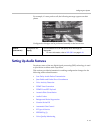
Administrator’s Guide SoundPoint IP / SoundStation IP
4 - 80
A wide range of performance metrics are generated. Some are based on
current values, such as jitter buffer nominal delay and round trip delay, while
others cover the time period from the beginning of the call until the report is
sent, such as network packet loss. Some metrics are computed using other
metrics as input, such as listening Mean Opinion Score (MOS), conversational
MOS, listening R-factor, and conversational R-factor.
Configuration changes can performed centrally at the boot server:
Dynamic Noise Reduction
Dynamic noise reduction (DNR) provides maximum microphone sensitivity,
while automatically reducing background noise— from fans, projectors,
heating and air conditioning—for clearer sound and more efficient
conferencing.
There are no related configuration changes.
Treble/Bass Controls
The treble and bass controls equalize the tone of the high and low frequency
sound from the speakers.
The SoundStation IP 7000 phone’s treble and bass controls can be modified by
the user (through Menu > Settings > Basic > Audio > Treble EQ or Bass EQ).
Configuration changes can performed centrally at the boot server:
Setting Up Security Features
This section provides information for making configuration changes for the
following security-related features:
• Local User and Administrator Privilege Levels
• Custom Certificates
• Incoming Signaling Validation
Central
(boot server)
Configuration file:
sip.cfg
Specify the location of the central report collector, how often the
reports are generated, and the warning and critical threshold values
that will cause generation of alert reports.
• For more information, refer to Quality Monitoring <quality
monitoring/> on page A-52.
Central
(boot server)
Configuration file:
sip.cfg
Specify the user’s preferences for treble and bass.
• For more information, refer to User Preferences <up/> on page
A-25.


















